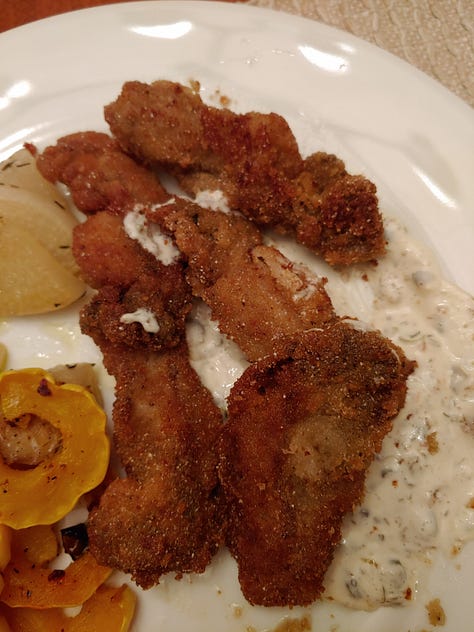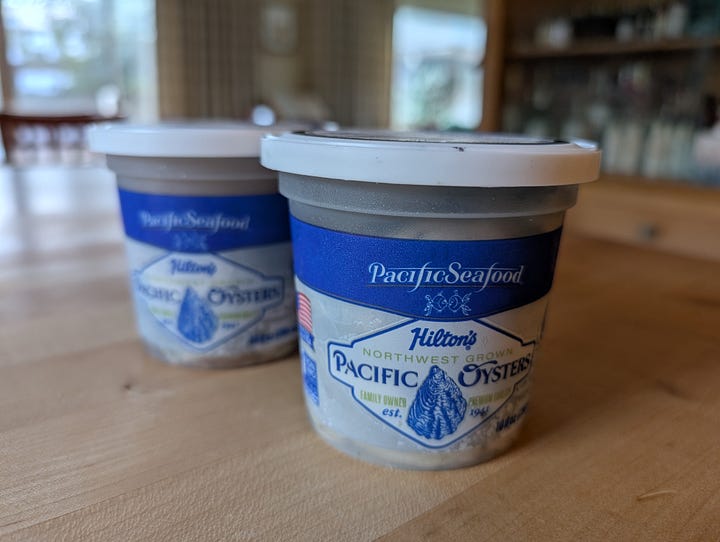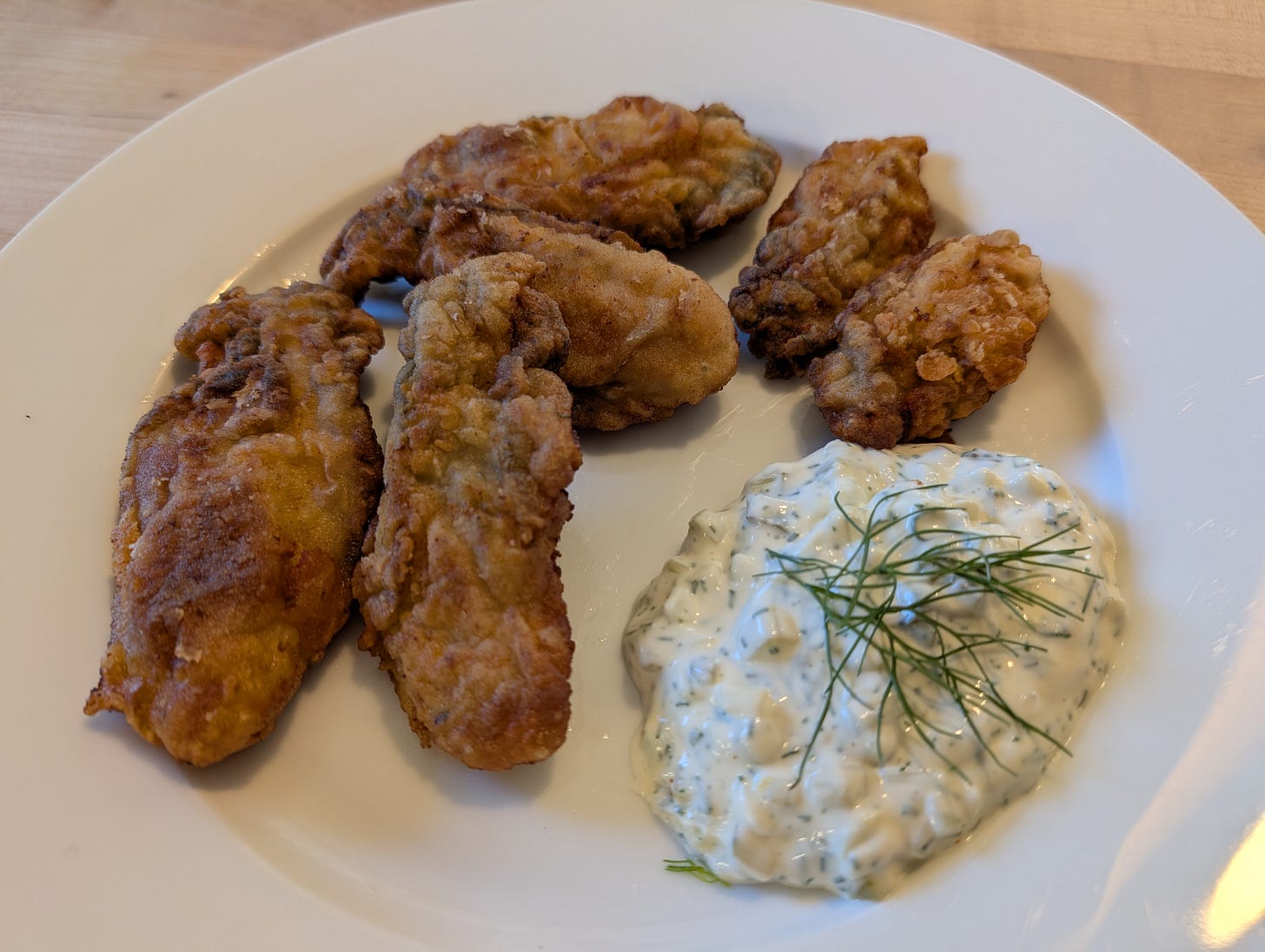Back to Oysters
My love and appreciation of a great pan-fried oyster, some thoughts on tartar sauce, and singing the praises of jarred oysters
Tuna melts a couple issues ago sure captured a lot of interest. At least for this little newsletter I’ve got going, compared to other issues I’ve published. It’s one small data point supporting the idea of comfort food’s universal appeal.
For my personal list of comfort foods, something I’d rank even higher than a tuna melt is a plate of pan-fried oysters. Simple! Nothing fussy. And I make a distinction between pan-fried and deep-fried, very much preferring the former.
The perfection of a pan-fried oyster relies, IMHO, on the coating having a near-crunch (especially in the frilly edges) in contrast to the tender meat inside. And the distinct browning that can be accomplished by contact with the surface of a hot skillet adds a bit of toastiness I love so much.
Alongside, a good homemade tartar sauce. Have I talked much about tartar sauce here yet? I don’t remember. But even when strapped for time and dinner relies on pulling some fish sticks out of the freezer, as it did a couple nights ago, I take a few minutes to make a tartar sauce while they’re in the oven. The recent version: minced green onion, a couple diced pickles, a microplaned garlic clove, and a splash of white wine vinegar was as far as I got with the mayo additions. Other times there may be some chopped Mama Lil’s peppers, minced herbs, capers, lemon juice/zest, among other embellishments. You’ve probably made tartar sauce at some point and have some favorites to add. Honestly, if I’m just too tired to function, I might stir a dab of harissa into some yogurt and call it good. Not tartar sauce, but an instant stand-in. I can’t abide a naked fish stick. Or fried oysters.



I’m sharing a pan-fried recipe below from my Oysters cookbook. But really, you don’t need a recipe. Here’s how to get there off the cuff.
The Oysters
you can shuck your own if you want to, but jarred oysters are perfect for this kind of recipe; more on them below
unless you want the fried oysters to be small for a particular use you have in mind—maybe a fun little canape for cocktail hour, or I’ve been known to fry little oysters to scatter over a salad like croutons—this is a good time to use larger oysters; keep in mind that oysters already small when raw will contract as they cook, becoming a bit smaller
otherwise, you don’t need to do much; just have your couple/few jars or tubs ready to open and get rolling
The Coating (there are so many potential approaches but I’ll keep it brief)
my preferred approach: pick your coating (below), toss the oysters in it and set aside on a baking sheet lightly sprinkled with a bit more of the coating for about 15 minutes; don’t dry oysters before doing this, just straight from the jar so the liquid on the surface gives the coating something to cling to; then toss the oysters one more time just before cooking, patting off excess
or you can do some form of triple-dip: first toss the oysters in flour, then dip them in milk (or beaten eggs, or a mix of both), then in a crumb of choice; granted, this bulks up the crispy-crunchy coating for the oysters, which I can get behind; but I get as much satisfaction out of a lighter coating and I love keeping it simple and less messy
what to coat with? more options than I can get into here, but starting points are good old all-purpose flour (or your favorite GF version), bread crumbs (dried, fresh, panko, each slightly different character), fine cornmeal, chickpea flour, fine cracker crumbs (saltine, Ritz, go meta with oyster crackers!); I’m sure I’ll think of five other options as soon as I send this off
The Cooking
pick a large, heavy-bottomed skillet—cast iron is an ideal choice
add about 1/4 inch of oil to the skillet (whatever type you usually use for frying, around here it’s a mild olive oil); you want to use enough oil so that the surface of the oyster is in contact with oil, including the wonderful nooks and crannies around the edge; you can add a smidge more after oysters are added to the skillet if it’s looking shy
preheat the pan and oil over medium heat, then add however many oysters fit the pan comfortably, with plenty of room to easily flip them and cook evenly; cook until you get a nicely browned surface on the bottom, a few minutes, then flip and cook on the second side
transfer the cooked oysters to a wire rack that’s set over a rimmed baking sheet to catch any drips; you can keep them warm in a low oven while cooking the rest, if you like; I don’t recommend draining them on paper towels, the bottom can quickly get soggy as they sit since the oysters retain a lot of moisture
All that’s left to do is transfer those delicious oysters to a plate, add a generous dollop of your favorite tartar sauce (or cocktail sauce? as long as there’s a nice dose of horseradish and it’s not sweet, I’m up for that too). With whatever suits your fancy alongside. For me that’d be a good homemade coleslaw and maybe some roasted potatoes. Or tator tots as a treat now and then.
If you’ve got a particular favorite way to pan-fry oysters, and/or favorite ways to serve them, let me know in the comments below. One recipe I included in Oysters is for Oyster Sliders with Togarashi Slaw, a really tasty twist for serving them.
Oysters in Jars and Tubs
I can understand how home cooks might feel that reaching for a jar of shucked oysters from their store’s seafood case is giving in to convenience over quality. More than a few times I’ve heard some version of that concern that pre-shucked = sub-par. I’ve been cooking jarred oysters for decades and have experienced only conveniece AND quality. I’m a big fan.


Oysters sold in plastic tubs or glass jars that are on ice or in a chilled case (not to be confused with shelf-stable canned oysters) are a great product for many cooking options. (Save the raw slurping for freshly-shucked oysters on the halfshell.) I’ve been to a few different oyster farms where I’ve watched these oysters get shucked, rinsed, put in jars, and topped off with a bit of water. That’s it. Oysters, pure and simple. And ready to pan-fry, deep-fry, bake, roast, stew, whatever you have in store for them. For a recipe in Shellfish I bake oysters in a bacon-lined ramekin with eggs and chives for a briny brunch option. So many possibilities.
When you see the sizes “small” and “medium” on jarred oysters, you might want to mentally translate that to “big” and “bigger”. I usually try to buy extra-smalls, an ideal size for most recipes. At that size, you’re likely to get 10 or so per 10-ounce jar. Maybe 8, maybe 12. I counted oysters in many dozens of jars while testing recipes for Oysters and Shellfish, and how many I’d get per oyster size and jar size varied. For a 10-ounce jar of “medium” oysters it could be as few as 4 big oysters, as it was with the tub I bought this week. In my research I saw that shucked oysters on the East Coast can have different size designations such as “standard” and “select.” Some producers may offer “yearling” size as well, smaller than “extra-small,” but I don’t see those very often.
Pan-Fried Oysters with Fennel Tartar Sauce
In a pinch, any delicious tartar sauce you can get your hands on will be a fine complement, but the savory crunch of this fennel version has extra character that’s worth the few minutes to whip it together. Not all fennel bulbs come with tender green fronds still attached; try to find a bulb that does. The greens make a nice herbal accent in the tartar sauce. If you’ve got fronds to spare, you can scatter them—whole or coarsely chopped—over the oysters just before serving. You may not get exactly 24 oysters from the few jars you start with but by weight the serving sizes should still work out; just might not be an even count per person. This is among recipes you’ll find in Shellfish.
3/4 cup all-purpose flour, more for sprinkling
1/2 teaspoon kosher salt
1/4 teaspoon freshly ground black pepper
24 jarred extra-small or small oysters, drained (from about 3 jars)
Mild olive oil or vegetable oil, for frying
Fennel Tartar Sauce
3/4 cup mayonnaise
1/2 cup finely chopped fennel bulb (see below)
3 tablespoons finely chopped cornichon or dill pickle
2 tablespoons chopped fennel greens
1 tablespoon white wine vinegar or freshly squeezed lemon juice, more if needed
Kosher salt and freshly ground black pepper
For the tartar sauce, combine the mayonnaise, fennel bulb, cornichon, fennel greens, and vinegar and stir well to blend. Season to taste with salt and pepper and refrigerate until ready to serve, preferably at least an hour in advance to allow the flavors to blend and develop. Taste the sauce again just before serving, adjusting the seasoning if needed. (Makes about 1 1/4 cups.)
Preheat the oven to 200 degrees F. Set an oblong wire rack over a rimmed baking sheet for draining the cooked oysters. Lightly flour another baking sheet or a tray for holding the coated oysters before cooking.
Stir together the flour, salt, and pepper in a large plate or shallow bowl. Add a few of the oysters at a time, tossing well to evenly coat with the flour, then lift them out and shake off the excess flour. Set the coated oysters aside on the floured baking sheet and continue coating the remaining oysters. Reserve excess flour. (Dedicate one hand to wet, tranferring oysters to the flour; another to dry, tossing in the flour and moving them to the baking sheet. This avoids ending up with gooey fingers on both hands.)
Heat about 1/4 inch of oil in a large heavy skillet, such as cast iron, over medium heat. Keep in mind that the heavier the pan, the longer it will take to preheat.
While the pan is heating, quickly re-toss the oysters 3 to 4 at a time in the flour to ensure an even, dry coating. When the oil is heated, carefully add about 6 of the oysters (don’t crowd the pan, cook fewer if needed) and cook until nicely browned, about 3 minutes. Turn the oysters and brown on the second side, 2 to 3 minutes longer. Transfer the oysters to the wire rack and keep warm in the oven while frying the remaining oysters. Add a bit more oil to the pan and allow to reheat if needed between batches.
Arrange the oysters on individual plates with a generous spoonful of the fennel tartar sauce alongside. If you have some spare fennel fronds, scatter them over the oysters just before serving.
Makes 2 to 4 servings [yes I’m suggesting one serving might be a dozen small oysters! seems right for pan-fried oyster fans like me]

Preparing Fennel Bulb
If you’re not familiar with preparing fresh fennel bulb, some tips. Trim the stalks from the fennel bulb at the point where they meet the bulb. Reserve the tender green fronds if needed in the recipe (as they are here, or save them use elsewhere as you would other herbs, added to a salad, sprinkled into scrambled eggs). Discard the stalks or save them for a batch of fish or vegetable stock.
Cut away the tough base from the bulb and set it upright on the cutting board. Halve the bulb vertically, from the top toward the base. If the outer layer is quite thick and tough, or bruised and blemished, discard it. Cut out the tough core from each half, then chop or slice the fennel as needed.






I’d be interested to see how the pac nw oysters stack up against my favorite Maine oysters!!